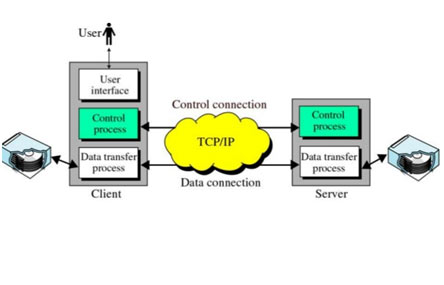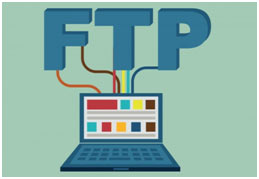File Transfer Protocol
File Transfer Protocol (FTP) is a standard Internet protocol for transmitting files in between computers on the Internet over TCP/IP connections. FTP is a client-server procedure where a client will request a file, and a local or remote server will provide it.
The end user’s machine is normally called the localhost machine, which is linked by means of the internet to the remote host– which is the second machine running the FTP software application.
Anonymous FTP is a kind of FTP that permits users to gain access to files and other information without requiring an ID or password. Some websites will allow visitors to utilize a visitor ID or password- Anonymous FTP allows this.
Objectives of FTP
- It provides the sharing of files.
- It is utilized to urge the use of remote computers.
- It transfers the information more authentically and effectively.
Mechanism of FTP
File Transfer Protocol(FTP) is an application layer protocol that moves files between local and remote file systems. It works on the top of TCP, like HTTP. To move a file, 2 TCP connections are used by FTP in parallel: control connection and data connection.

The control connection
For sending control information like user identification, password, commands to alter the remote directory site, commands to retrieve and save files, etc., FTP utilizes a control connection. The control connection is initiated on port number 21.
The Data connection
For sending the actual file, FTP uses a data connection. A data connection is started on port number 20.FTP sends the control information out-of-band as it utilizes a separate control connection. Some protocols send their demand and reaction header lines and the data in the very same TCP connection. For this reason, they are stated to send their control information in-band. HTTP and SMTP are such examples.
FTP Session
When an FTP session is started between a client and a server, the client starts a control TCP connection with the server-side. The client sends control information over this. When the server receives this, it starts a data connection to the clientside. Only one file can be sent out over one data connection. But the control connection stays active throughout the user session. As we know HTTP is stateless i.e., it does not have to keep track of any user state.
FTP Server
The FTP server can support both active and passive connections with the FTP client. In an active FTP connection, the client opens a port and listens while the server actively connects to it. Whereas, in a passive connection, the server opens a port and listens passively, which allows the client to link to it.
A passive connection is more safe and secure and also preferred by IT admins because data connections are made from the FTP client to the FTP server. This is a more reputable method, and it prevents inbound connections from the Internet back into specific clients.
FTP Client
FTP clients were simply command-line user interface (CLI) applications a couple of years ago. They now come in easy-to-use, instinctive interfaces to help with and simplify file transfers. FTP clients are used for desktops, servers, and mobile devices, and are available as standalone apps.
Web clients, and simple extensions to Web internet browsers. FTP Voyager is a FREE Windows FTP client from Serv-U that supplies a host of built-in functions to simplify file transfer.
Different File Transfer Protocols
1.FTPS
FTPS is an extension protocol that includes Transport Layer Security (TLS) and Secure Socket Layer (SSL) encryption protocol support to the commonly utilized file transfer protocol (FTP)
2.SFTP
It can be used in several applications, such as secure file transfer in Transport Layer Security (TLS) and transfer data management in virtual private network applications Program.
3.SCP
The old protocol, SCP or Secure Copy Protocol, is a network protocol that supports file transfer in between hosts on the network.
4.HTTP and HTTPS
As the backbone of the Web, HTTP (Hypertext Transfer Protocol) is the basis of data communication. HTTP utilizes TCP (Transfer Control Protocol) as the underlying transfer and is a stateless protocol. HTTPS (Hypertext Transfer Protocol Security) is a safe version of HTTP in which communications are encrypted by TLS or SSL.
5.AS2, AS3, and AS4
AS2, AS3, and AS4 are popular protocols used to send and safeguard important file transfers.AS2 is utilized to transfer sensitive information safely and reliably on the Internet.AS3 is a standard and can be used to move almost any file type.AS4 is an agreement that enables businesses to exchange data firmly with their partners.
6.PeSIT
PeSIT protocol is an end-to-end file transfer protocol developed by the French Interbank Telecommunications System Economic Interest Group (GSIT).
Benefits of FTP
Speed: Among the most significant benefits of FTP is speed. The FTP is one of the fastest methods to move files from one computer system to another computer
Efficient: It is more efficient as we do not need to complete all the operations to get the whole file.
Security: To access the FTP server, we need to login with the username and password. For that reason, we can state that FTP is more safe and secure.
Drawbacks of FTP
The basic requirement of the industry is that all FTP transmissions must be secured. However, not all the FTP providers are equivalent, and not all the service providers use file encryption. So, we will need to keep an eye out for the FTP providers that offer encryption.
Passwords and file contents are sent out in the clear text that allows unwanted eavesdropping. So, it is quite possible that assaulters can perform the brute force attack by trying to guess the FTP password.
It is not compatible with every system.

